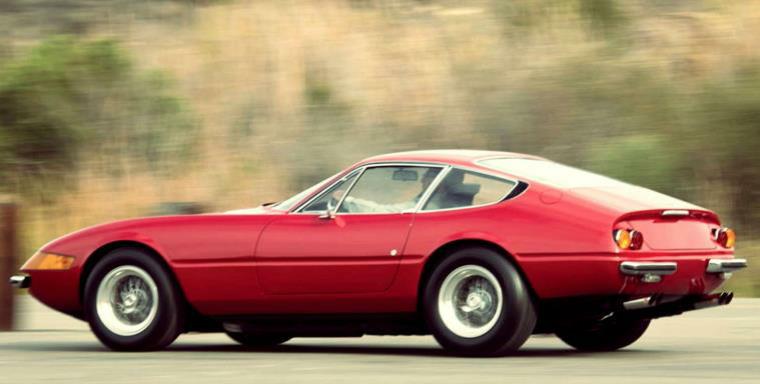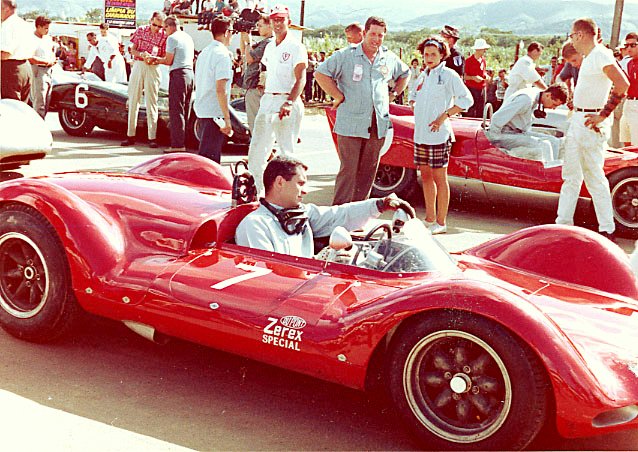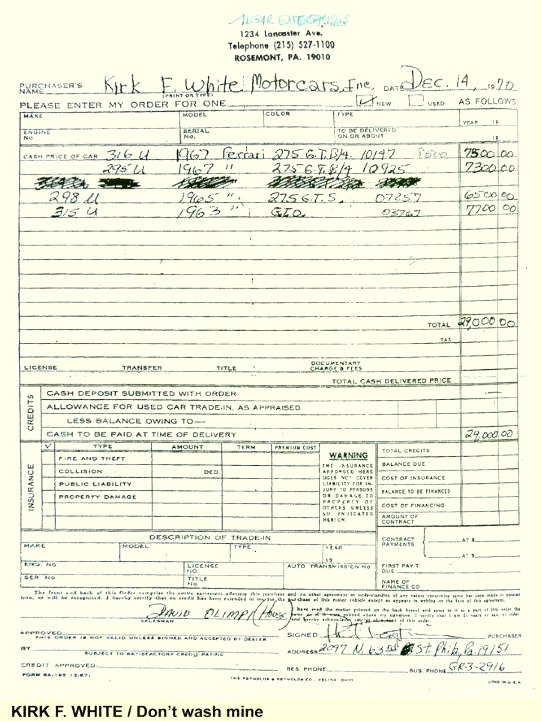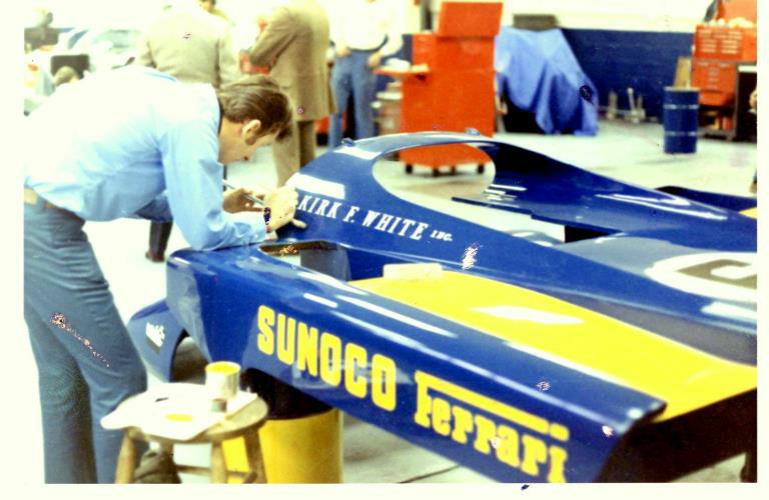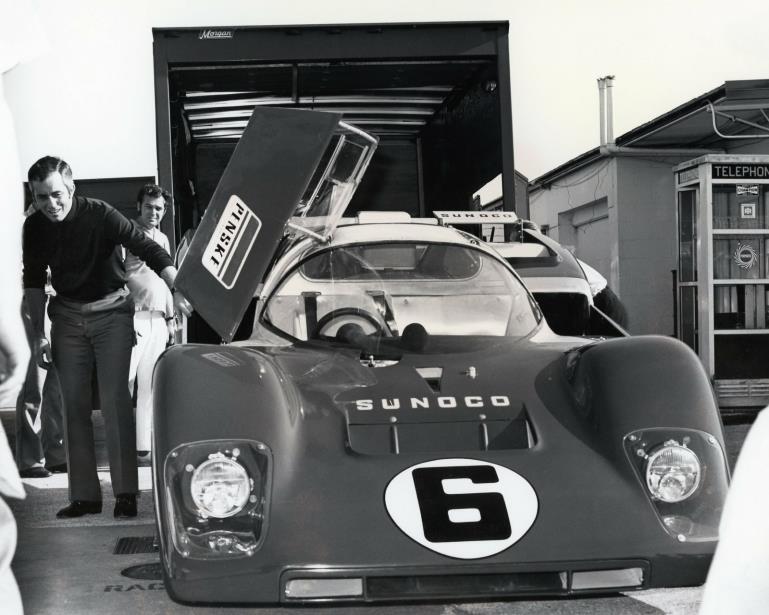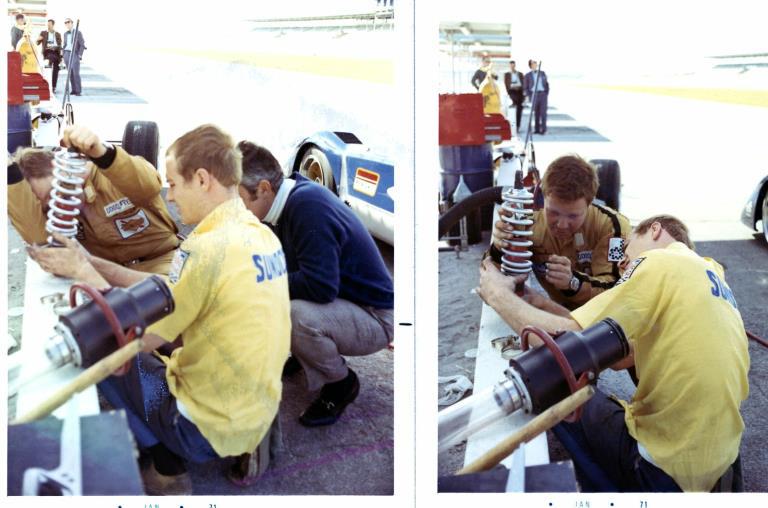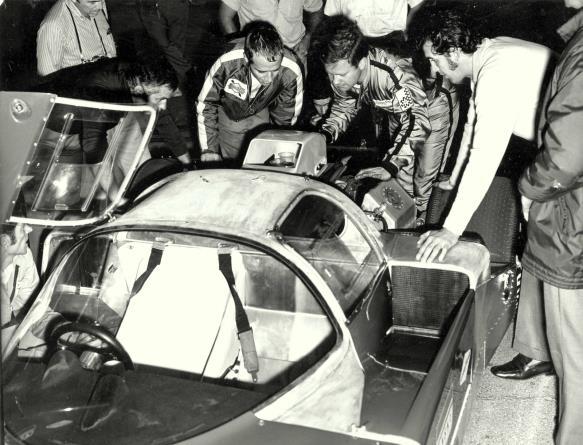Chapter 15
483
FERRARI 512 #1040 BEGINS ITS TRANSFORMATION

Soon it was Thanksgiving and immediately after the holiday, Roger and Mark flew to Italy to go shopping for the necessary replacement parts.
After a warm greeting from the people at Maranello, they settled down and put together the order for what they felt was essential to the effort. The order included a spare engine.
After getting their extensive parts order rounded up, Roger and Mark were offered a tour of Ferrari’s fabled racing department. One of them, almost certainly Roger, said they didn’t really have the time!
Then Roger asked about the prospect of a discount on such a large parts order, to say nothing of the fact that we’d be carrying the company flag in to battle so to speak.
That request was rejected out of hand.
Mark, ever the inquisitive one, was watching the final assembly area for the 365 GTB/4’s and asked one of the nearby Ferrari workers:
“How can you guys just say that these Daytona’s will top out at 172 Miles per hour?”
“Come, I show you” . . . the Ferrari man motioned Mark into the passenger seat of the 365 GTB/4 that had just come off the line.
484
Roger called me from Italy and told me hustle up the $28,000 plus for the spare engine and the parts. Great. So far the car was $32,000 and the parts were $28,000. Now we had a staggering $60,000 in the car!
(Think that’s funny? . . . that money in 1970 would easily buy you four 250 GTO’s and an alloy 250 SWB Berlinetta . . .)
Then everything went dark for a period. No calls, no word from Penske Racing. We went back to selling and acquiring automobiles, motorcycles, engines, shotguns, vintage Thompson Sub-Machine guns and just about anything to keep the furnace stoked.
Finally I called the Penske race shop, and asked timidly if I could stop by and visit at a convenient time.
“Certainly, it’s your car! Come anytime. The way we’re going flat out on this car, I do mean, literally, any time.” said, Chuck Cantwell.
That evening after dinner I drove over to the shop in Newtown Square. It was only eight miles from my house.
I walked in and several people were working. I was introduced to everyone. I pretty much walked all around the shop. The shop wasn’t that large. The Ferrari wasn’t there!
I asked John Woodard: “Where is the Ferrari?”
“Right there” said Woody, pointing at what appeared to essentially be a pile of scrap.
I had chosen to visit the project, literally the day the car had been stripped to a bare carcass. The engines had gone off to Traco Engineering in California. That was exciting; Travers & Coon were among the very top racing engine builders in America, period. And, they did all of the Trans-Am engines for Penske Racing.
Letting good old southern California hot rod engineering loose on those engines was one of the features that had drawn me into this whole scheme.
485
Berry Plastics in California was doing the body pieces in a stronger, yet considerably lighter fiberglass. Mark and Don Cox were resetting the suspension points to their design and the legendary metal fabricator Lujie Lesovsky was brought on board to build the wing that Don Cox felt was the single most glaring need with the 512. It was the first thing that struck Cox as the Ferrari came out of the truck.
It then all started to come together pretty quickly. I was most anxious to hear what Traco had learned with the engines. Word came back to me that they had found them both to be pretty damn well built and had really done little more than open the intake runners and the heads, and balance the moving parts in the engine to a fare thee well.
Mark had gone out there for the dyno run ups with both engines. The spare engine . . . (nope, I don’t know the serial number on that engine, never did.) had a factory figure of 596 horsepower on an attached tag. Traco found the tag to be somewhat optimistic.
On the dyno, they ran the first engine up, made some adjustments, and ran it up again. They tried all their good tricks and the motor just seemed to hit the wall at 590 HP each time.
Mark was good enough to relate all this to me as he knew my belief in the injection of American engineering into this entire effort was really going to be the linchpin.
They had shut the dyno down and reviewed all the data they had. Something really troubled Mark about the results.
“What are these motors running for oil pressure?” Mark asked.
“Factory recommended 125 psi” someone said.
Mark stepped in and backed the relief valve down to 60 psi.
They re-fired the engine, ran it up, and the horsepower shot to 614HP! Plus, the motor spun more freely. In fact, it seemed it would have been happy to spin itself to oblivion.
486
Mark explained to me that with that much oil pressure, the oil was literally becoming a jellied mass in the timing chest, dragging the power down.
“Heck, 15 psi will shoot oil ten feet in the air.” Mark said.
Two things about that little incident: First, the genius of Mark Donohue coming to the fore in the midst of a frustrating afternoon in a dyno room, manned by the top engine builders in the country. He just logically came to that simple solution.
Secondly, he had returned to Philadelphia and taken the time to explain it all to me, in detail, the logic of it and how it had transpired. That was just the way Mark was, a very considerate man.
(Many years later we were having a Cannonball reunion in Watkins Glen, in conjunction with a vintage racing weekend. . . The Shelton Ferrari 512S was entered for the track events. I always enjoyed seeing a 512, so I wandered into their garage area. The mechanics were all over the nose of the 512 which was soaked in oil. It was the second time that day that an oil line had blown off the oil cooler. They weren’t having fun.
“What kind of oil pressure are you running?” I asked, in what I thought was a subdued, friendly manner.
The looks directed at me were mostly:
“What the fuck business is it of yours?”
A voice said: “120psi.”
“When we ran the Sunoco 512, Mark found that 60psi, not only upped the power on the motor but all pressure junctions stayed intact.”
The looks I got pretty much said:
“How ‘bout getting’ the hell out of our garage?”
Our 512 is today owned and driven by Lawrence Stroll, and is under the very capable care of Wayne Menniker. I shared the same info with him when we met. Wayne put it into play, and today that old # 1040 warhorse is everyone’s worst nightmare when it shows up for a vintage event! )
Ferrari 365 GTB/4-Road Testing . . .
It was pouring rain but the factory man took Mark out on the Autostrada and drove the car to a true 173 MPH in the rain and traffic. The engineer told him that any Daytona that did not reach that velocity would be brought back inside and tuned until it did attain that speed. Mark was impressed with the “no nonsense” approach to their speed claims!
489
On and on the practice went, Roger pressing, but encouraging at the same time. He never demeaned anyone. Time and again they drilled.
Quite a bit later, Roger, sent someone out for food, turned back to the crew, and said:
“We can stay here all night if we have to; this car needs 70 gallons on board in seven seconds, consistently.”
That statement along with some food, and they were getting it done consistently late that night.
Again, from Penske Racing, innovative cutting edge technology and a team dedicated to making it work to the team’s exclusive advantage.
A day or two later I received an unrelated telephone call . . .
“THE DEAL . . .”
In early December of 1970 Dave Olimpi called from Algar Enterprises. It was rare for the two enemy camps to exchange any verbal communication directly. Generally any words uttered consisted of derogatory dialogue, related to us through a secondary source.
ALGAR: “They are not authorized Ferrari dealers and they never will be!”
WHITE: “We are not a factory store, and never will be, but we have the exact car you want, brand new, on a certificate of Origin, at considerably less money. Do as you please . . .
David said they had some used cars that they were interested in moving on.
“Fine, I’ll come and have a look.” I said.
“Uh, could you have Phil come? I don’t think it would be a good idea for you to show up here . . .”
I thought, don’t get all huffy here, Kirk; they’re looking to sell two 275 GTB/4’s, a 275 GTS, and a 250 GTO. Just suffer the fact that you are persona non grata in Rosemont.
491
“You want ‘em?” growled the ‘manager’ who up to that point hadn’t uttered a word. He was middle aged, pasty complexion, badly fitted wire rim glasses, and portly. His belly hung over his belt and his shirt buttons were hoping the day would end soon. He had a miserable, nasty, demeanor.
I turned, put my hand out, and said: “Hi, Kirk White . . .”
“I know who you are . . .”
Well, okay then, we’d try this another way, I thought. The GTO looked fine, and so did the others. The price was too dear.
“Whattaya’ a wise guy?” said the manager.
Dave explained to him that I was offering $25,000, not 25 cents. A few give and takes with Dave and we landed at $29,000 for the four Ferraris. The “manager” was purple in the face at that point. He hadn’t been included in any fashion.
It was December 14, 1970 and it was a Monday. I said I’d pay for, and pick up the cars, late that Friday afternoon figuring I could “miss the bank” by getting there on a Friday, after 2 PM . . . and pick up the weekend “float” on the money, as it were.
As I departed, literally as I was passing through the door opening, the “manager”, whose name, I forgot to mention, was Sowers, piped up:
“It better be in cash!”
I paused, already through the door, and then merely said as I let the door close:
487
One early December morning, I had gone to Molin’s body shop in Wayne. I had heard that the 512 was there as a rolling chassis.
Harry Tidmarsh, Molin’s top fabricator, had a separate small work area in a back corner. Harry was a superb metal man and craftsman. He and “Axle” Gane had built Roger Penske’s notorious Cooper Zerex sports racer which was the scourge of the SCCA, and was outlawed after devastating everything it encountered during the season.
Roger Penske in the notorious Cooper- Zerex Special
Harry was the man Alcoa Aluminum went to for their special aluminum fabrication needs. I walked into the small work area and there was Harry sitting on one of the Ferrari door sills. The legendary Indianapolis car builder, Lujie Lesovsky was sitting on the other. They were quietly working together fashioning the coupe roof for the 512M.
I wasn’t the only one in the room; there were two or three other guys. No one spoke, all of us just wanted to quietly watch these two wizards ply their craft. I stayed for a long time, and have always been grateful to have been there that morning
488
PRACTICE, PRACTICE, PRACTICE
Roger was planning a surprise for the competition. The Ferrari was going to utilize the very first of the quick connect fuel fillers. Large diameter (5 inch) hoses with larger plug in nozzles.
They were essentially the same type fuel hoses that are used today with the Indianapolis type cars. The two 5 inch hoses, both intake and overflow, would plug directly into the fuel tanks low on the left side of chassis tub. The fuel would flow rapidly from the forward hose, and when the fuel appeared in the clear section of the rear hose, the tanks would be full, the nozzle fittings would be yanked back, and the car would be on its way.
They were a brand new item for the team, and for that matter would be a surprise for all the other Group 5 competitors.
Even today, these couplers, though incredibly efficient, are still far from an exact science. They are tricky to connect and disconnect cleanly.
Ed Casey and I had arrived at the race shop about eight in the evening and the team was “dry” practicing on the car using the connectors.
Roger was right there with the team, timing the crew members with a stop watch. Someone had determined that once the connecters were coupled into the Ferrari, the car should be able to take on 70 gallons of fuel and be loose to leave the pit in 7 seconds!
Well, not yet that night. The team “coupler” guys were having a heck of a time getting the whole procedure together. I’m sure they’d toiled the entire work day and then been pressed into this military drill with “you know who” there to make damn sure it was going to be successful.
The couplers and the hoses were big and cumbersome to the rookies. To compound matters one nozzle fitting was very low in the car and the upper one was angled. Each coupler needed to be fully aligned with the receptacle to slide in and connect, with even the slightest misalignment, it wasn’t going to go in.
490
Phil went up to Algar and came back with good descriptions and a price of $35,000 for the four Ferraris. The cars all sounded fine, but I was concerned about the GTO being finished in a rather tired dark green and right hand drive.
I told Dave I’d like to try to buy the cars, but we were somewhat apart on the price of the package. More importantly, I really needed to see them with my eyes. I wanted to see how the GTO actually struck me.
Things went dark for few days, then a call. Algar had found a time slot, late one afternoon, where it appeared all persons who might be adversely affected by the sight of me would be well clear of the Algar Enterprises premises.
I wish I could say that at the appointed late hour I’d stepped out of a long wheelbase Mercedes 600 Limousine in a long black overcoat, a fresh Punch cigar clenched in my teeth, and my “Brown Brothers Harriman” checkbook tucked under my arm. Two towering “gentlemen” in dark suits would have been accompanying me.
Not quite.
Dave greeted me. With him was a “manager.” The manager merely stared at me with an unpleasant gaze. Dusk was falling; the scenario was something out of a bad movie. The lights in the showroom were at a “Jerome Avenue” low level. The four cars I was considering were parked outside the building tightly against one another in a cold corner of the lower back lot.
They looked like a condemned group of Ferraris, destined to an evil end at Kirk F. White Motorcars.
“Nicely positioned” I said, smiling to Dave, gesturing toward the four Ferraris.
It was quite cold outside, and the final threads of daylight were evaporating quickly.
492
“You bet . . .”
The following morning, Tuesday, I told our gal Carol, I would need $29,000 in tens, fives and a few, but not many, twenties. No rush, I wouldn’t need it until Friday afternoon.
Bryn Mawr Trust bank was good enough to accommodate my childish request. The bank had the cash all neatly wrapped. I cut all the bands off and tossed the money in a large paper bag. Friday evening, just prior to their closing, I, and four drivers from our Overbrook neighborhood, strolled through the door of Algar Enterprises with our sack filled (and it damn near was!) with $29,000 in United States currency.
It was perfect; twenty minutes away from closing, the Algar “Manager”, Sowers, was sitting placidly in his office waiting out the last few minutes till closing, when the five of us came through the door like Chicago gangsters. Sowers burst out of his chair, wildly eyeing the group of thuggery headed for his office.
The drivers spread out around the showroom to eye the cars. I entered Sowers office and from a height of a foot or so, I let the “bag” land on his desk with a thud. Sowers sat back sharply in his seat.
“What the hell is this?” he shouted.
“It’s your fucking $29,000 in cash for the four Ferraris that we’ve bought! I’ll need the keys and the titles now. I’ve got drivers with me . . .” I said, gesturing to my west Philly crew roaming his showroom.
Out of the corner of my eye, I saw Dave Olimipi, quietly smiling in the showroom, as all this unfolded.
It took forever to get it all squared up and get us out of there.
493
“Sowers had peered in the bag, but he never even tried to count the money.
I drove the GTO back to 63rd Street. It was a peach. As I recall, Colin Crabbe was glad to take the Ferrari along back to Great Britain shortly thereafter.
The Invoice on this deal has floated all around the internet for years. Now you know the rest of the story.
"THE INVOICE!"
494
FERRARI 365GTB/4, SERIAL # 12547, ALLOY COMPETITION PROTOTYPE #1
This was one of the very first 365GTB/4’s to come to the United States, and definitely the prototype for all the “comp” Daytona’s to follow.
Its first owner, Brindisi Gherardi in Italy, had agreed to enter the Ferrari under Luigi Chinetti’s North American Racing Team banner for the 1969 24 Hours of Le Mans..
The alloy bodied car was a bare bones Daytona, but still had electric windows! No air conditioning, but not much in the way of really big time race car preparation, either.
For the 1969 Le Mans 24 hour race, Sam Posey and Bob Grossman were named as the drivers. During the spring practice at Le Mans, Bob Grossman suffered a major loss of control on the Mulsanne straight and the car was heavily wrecked. It returned to the factory, and was rebuilt.
At some point Chinetti took over ownership, and brought the Ferrari to America.
#12547 was entered for the 1970 24 hours of Daytona with Masten Gregory and Wilbur Pickett named as drivers. Ronnie Bucknum and Pickett ended up as the actual drivers. A little over two hours into the event the car was retired with overheating problems.
The car was then listed as a NART entry for the 1970 Sebring 12 hour race with Harley Kluxton and Wilbur Pickett shown as the drivers. But for one reason or another it did not start the race.
The car returned to Chinetti’s in Greenwich, and as soon as I laid eyes on it, I tried to buy it.
495
“No, it ees’ not for sale! . . .” hissed Luigi in that tone he could take when he thought someone was way out of line.
It was a NART team car; you didn’t ask about those cars.
Then one day, I guess the Ferrari was no longer a “team” player and Luigi asked me some horrendously outlandish figure for the Daytona. At that point the car was beginning to look more than a bit down at the heels.
Still, there were no US legal Daytona’s yet. America was putting in place its DOT and EPA standards, and Ferrari was not terribly interested in the legislation written by the American politicians who hadn’t a clue as to where they were headed with those regulations.
With our 512 having reached a large paw into our company cash drawer, it was not the most prudent time to be considering the purchase of a thoroughly clandestine, wrung out, competition Ferrari 365 GTB/4.
It’s just that the car said:
(“C’mon kid, let’s get outta’ here . . .)
Luigi must have been ready to sell the Ferrari, because the price I dumped on him was very low. I felt I could at least say I made the effort and move on to other sensible business.
But my price was accepted! I made arrangements for one of the Drivers on Jerome Avenue to take back the 330 GT I had driven that day, and I drove the alloy Daytona back in myself.
496
The Daytona sure was a big ol’ Ferrari, after driving my 275 GTB/4 for so long. Outrageously heavy steering at low speeds, biggest turning circle I’d ever encountered in any automobile, very good ride, great gearbox, lots of torque, but not so much “crisp” right now, power. It all came at you like a gathering storm. Splendid exhaust.
The following day I gave it to Mike Tillson to sort out. Checking with him mid-afternoon, he said the compressions were all over the lot.
(. . . That’s it Kirk, just keep on buying these damn old race cars without any homework at all.)
At the end of the next day, Mike had saved my fanny again, by adjusting the valves, punching the distributor advances forward, and setting all six Webers so they would at least acknowledge each other’s presence.
He’d turned the Ferrari into a rocket ship. Boy, that car was wickedly fast. And the exhaust note was the best I’ve ever heard from any Daytona.
As we had formed our relationship with Penske Racing, we painted the #12547 Ferrari Sunoco blue with Larry Schoppett doing the pin striping in yellow!
The following few lines quickly bring into focus the way we actually used these Ferraris, Lamborghinis, Maseratis etc, and enjoyed fantastic experiences with them, literally on a daily basis in the late sixties and early seventies.
I loved that Ferrari. It not only became the company flagship, but it became my daily driver. I would drive that Daytona to New York, park it on Jerome Avenue for the whole day, then drive it down the west side of Manhattan to Ponte’s restaurant, deep in the darkest warehouse district of the lower west side of the city, and have a fantastic Italian dinner with friends. The Ferrari would merely be parked on the street in the darkness of that industrial area.
497
After dinner, more often than not, I’d drive the Ferrari back to Philadelphia with a small snifter of Drambuie on board, cruising home at a brisk velocity, doing what I could to stay below the state police radar.
It wasn’t too long after I bought the car, that I had one of the earliest “mobile” telephones put in the Ferrari! It was monstrous, complete with a rotary dial, perched on the console. There was a fifteen pound electronic box in the trunk!
(. . . Did someone ask if “ debaucherous, foolhardy, bastard” was a proper expression?)
It gets worse. In very early ’71 when we went to run the 24 hours at Daytona with the 512, I had Bill Kontes drive the Daytona down for race week!
Mark Donohue took a shine to the car and literally drove it away for the entire week! But that’s a bit ahead of where are . . .
(. . . Were we a fiscally responsible company, or what?? . . .)
THE FINAL COMING TOGETHER
David Penske and his wife were hosting a holiday party just before Christmas. That night Roger said to me that they had really pulled out all the stops on the Ferrari, and it was really turning out to be a fantastic race car.
“We’ve put more effort into that damn Ferrari than our Indianapolis cars!” said Roger.
The following day, a Sunday, I was asked to come to the shop in Newtown Square to meet Mark’s co-driver in the Ferrari, David Hobbs.
I’ll merely say that having David join the team was an outstanding choice. He is a truly remarkable gentleman and an enormously capable racing driver.
498
Usually I am a runaway fountain of verbiage; in the case of knowing and working with David Hobbs, I’m left reaching for superlatives that haven’t been all used up.
I count myself very lucky for having David and his marvelous wife Margaret in my life.
The first major race, the 24 Hours of Daytona, was to be run, Saturday January 30, 1971. The car was really coming together at Newtown Square, and I was trying to visit there almost every evening.
I’d quietly watch the team members bringing the Ferrari to completion, . . . if there ever is such a thing as “completion” with a leading edge racing car.
I very much stayed out of the way and held my questions to a minimum.
Roger had leased the track at Daytona for a two day closed course testing session, just two weeks ahead of the race.
In the final preparation stages, Larry Schoppett came to the shop to do all of the graphics and lay down his very distinctive pin striping.
In today’s rapid fire world all of the decals, sponsors logos, lettering, numbers etc. are done by computer driven adhesive transfers. It’s merely a matter of getting them on straight.
Not so for Penske Racing, circa 1971. Virtually every visual feature of all of the Penske racing cars was hand enameled by Larry Schoppett, even the small Champion spark plug logos, and the multiple Good Year markings.
Larry was Philadelphia’s answer to Von Dutch, except that he wouldn’t get trashed at the end of a job and then possibly walk over the top of your automobile! But I digress . . .
Larry had incredible abilities, and would often work through the night to get a race car done.
499
Take a look at some of Mark’s McLaren and Lola Can Am cars, with their elaborate striping accents, “Von Dutch” type embellishments, etc. Insanely labor intensive, but the edge it provided was a very visual part of seemingly small “extra efforts” that put the Penske team into an upper echelon all their own.
Somewhere on each of Penske’s racing cars, Larry would incorporate, within an intricate Von Dutch type design, a tiny scorpion to ward off bad luck. Don’t let anyone tell you Roger wasn’t superstitious.
Our company name “Kirk F. White” was painted in upper case “Times Roman” in white enamel on the sail panes of the car right above the bold SUNOCO FERRARI lettering, which was running above the rear wheel openings, fully the length of each rear fender.
"First Lettering . . .".
500
Roger had opened a new company, Penske High Performance Products, which had a spot on each door.
The Ferrari was just stunning! You couldn’t take your eyes of it. It was still a distance from finished, the roof was still in raw aluminum, but it was ready to get to the track.
I travelled to Daytona Beach for the testing session. It occurred to me that this was the first time I had been back to Daytona since the hard working, poverty stricken days in 1957 and 1958.
Barely thirteen years later, I was back in Daytona, involved with what was giving every indication of being, possibly, the most potent sports racing Ferrari of all time.
I was standing next to Bloys Britt, the great veteran motorsport Associated Press writer when the 512 came out of the transporter, virtually at the moment you see in photograph below. Note the intense concern on Roger’s face!
Credit: Dave Friedman
"First Light of Day" . . . Note Penske's Careful Concern.
501
Britt and I were just a few feet away as the winch was slowly letting the car down the ramps. Britt was a giant of a man, a motorsports writing equivalent to Alfred Neubauer, the ruler of Mercedes Benz racing!
He leaned down to me and simply said that the Ferrari was “the single finest, and most beautiful racing car, he had ever seen.” Britt was not prone to that type of statement. It was a remarkable comment.
Once on the ground the car was attended to like the brand new baby that it was.
And then, after all the usual “get ready,” Mark stepped into the car, fired the engine, and slowly rolled out of the pit area.
Yes, I’d heard the chassis running from a distance during the lift and drag tests at Reading, but this was the very first time I had heard the Ferrari fire as a Penske team racing car. It was altogether different.
It was emotionally overwhelming. The fact that we were in Daytona had a lot to do with it, I think. I distanced myself from the others as all of that incredible experience just rolled over me like a great wave, from a simple idea just some months back, to this unbelievable moment.
As the Ferrari pulled away and gained speed, the exhaust note was indescribably wonderful, and the car was just stunningly beautiful.
I walked out by myself to the far edge of the pit lane and watched the car gain momentum rolling toward turn one. It was an unforgettable experience. If I’d had to speak to anyone, it wouldn’t have gone very well.
The testing session was a real learning experience for me. I stayed to the side, certainly having nothing to offer, but was completely absorbed in the team’s methodical, dedicated efforts in setting up the car.
502
The Ferrari would go out for a bit and back in for adjustments, some minor, some entailed a good deal of effort and thought. Suspension changes, wing adjustments, some imperceptible. Mark and Woody were relentless in their pursuit of perfection
512M Testing Daytona 1971 "Woody" Mark Roger
For his part, David Hobbs stepped into the car and simply went very quickly, with no fuss at all. His input throughout the test session was tremendous.
Being able to be there for that entire session was a great experience for me. At one point I wandered over to the infield horseshoe turn and watched the car passing through that point in the infield.
Even though the horseshoe turn at Daytona is a fairly slow going bit of the course, I noticed that the “Kirk F. White”, in its small, elegant print had diminished into a thin white strip of nothing on the car! Hmm. . . now with my name “up in lights,” so to speak, that was disappointing. I watched for a few more laps and it wasn’t getting any better.
That evening I had dinner with Bill and Mary Lou Deems, whose Amoco station in Florida I had managed in 1957 (14 years ago). They had been so very good to me and had sent a lovely letter of recommendation to the Penn Mutual Life Insurance Company when I returned to Philadelphia.
After the test session, we all travelled back to Philadelphia, and I got to meet the newly hired Dan Luginbuhl, who would head the public relations end of things for the various Penske companies.
503
The few changes that needed to be made with the 512 were executed. At that time, I told Roger I wasn’t really settled with our “company exposure” on the car. He said to do what I felt worked, and he’d have a look at it.
(. . . did you get that “company exposure” nonsense; vanity, thy name is Kirk F. White!)
Just days before we were ready to load up and go for the race, I came in to the race shop one evening to find Larry Schoppett busy lettering up the Ferrari for the “big show.” He had painted KIRK F. WHITE in the brilliant Sunoco yellow. It sure wasn’t going to be missed now.
Roger had remarked to Larry that it was too large.
“Too late, I’m out of time with this car.” said Larry. “It is Kirk’s car, isn’t it?”
Larry and Ed Foody on the other side of town were the premier Pinstripers in Philadelphia. Most any Saturday, I’d see Larry at Molin Body Shop plying his craft, often with John Surotchak, who to this day remains Philadelphia’s automotive and bon vivant and a superb raconteur!
Everyone in the shop was busy, very busy, what with the Ferrari, the Lola Formula 5000 car, and now the new McLaren M16 Indianapolis car, to say nothing of the upcoming Trans Am season with the AMC Javelins.
504
It seemed everyone we knew in Philadelphia was coming to the race. The whole project was taking on a major presence among the automobile people we knew everywhere.
Then, just before we were all ready to leave for the 24 Hours of Daytona . . .
A FERRARI IN THE FARM FIELD . . .
Here we are in 2016 and the vintage car hobby is all caught up in “barn finds.”
Well, barns are usually found on farms, so here’s a funny little “Farm” story, circa 1971. The week before we left for the 24 Hours of Daytona, I was up in the Lancaster County area on business late one afternoon and stayed to have dinner with a couple of friends who were local Ford dealers. The conversation came around to vintage cars and Ferraris in particular.
The restaurant dining room was dimly lit and at a point during dinner a somewhat wild eyed, sketchy guy came to the table and stated:
“I know where there’s one of them ‘Fiaris’”. (he pronounced it “Fyarii . . .”)
“It’s on a farm less than five miles from here. It ain’t in great shape, but it’s out there.” he said. We finished dinner and the guy said to me:
“Ya’ wanna’ see it? It’s out on the fields . . .”
I wasn’t exactly up for the idea, but the guy pushed, and we all took a ride out to the farm in the guy’s old beater van. We turned into the farm driveway and headed down toward a big old barn.
505
But wait, we drove right on around the barn and started bumping over a winter plowed dirt farm field. We were all bouncing around in this van like pin balls. There was a very bright moon and all I could see in every direction was plowed farm land. Suddenly he pulled to a stop and jumped out of the van.
“C’mon here it is.”
I was just plain scared. We’d stopped at one of the “diamond” junctions where a farmer turns his tractor for four different fields.
You’ve probably seen them in aerial shots of farm fields. Drug enforcers are always eyeing them carefully from their choppers, hoping to catch an active crop of marijuana. In this case, it would be a bit of an Italian automobile moldering away in the midst of this farm field. It was, in fact, an early Ferrari 250 GT 2&2.
It was a difficult scenario to take in. I looked over what was essentially a carcass. Fortunately the moon was out that evening. A good deal of the silver paint bodywork remained. The wheels and front suspensions were off the car. All the bright work was gone. The windshield was gone. Corrosion was beginning its march through the lower sections of the Ferrari. As close as I could tell it had not been wrecked.
Oddly the engine and gearbox appeared intact. It was an awful sight. The car wasn’t that old.
“What do you want for this?” I asked.
“Eight hundred and there ain’t no title an’ I ain’t gettin’ it outta there neither!”
“$500 and I’ll drag it out,” I said . . .
“You got cash with ya’?”
I wasn’t about to hand over cash without a rollback right there with me to drag the carcass away. I picked it up the following day and sold it to a young man that owned a body shop in Lebanon, Pennsylvania, not so far from where the hulk had lain in the field!
It remains my strangest find of a Ferrari automobile ever!
Coming Next Chapter 16
September 6
The 24 Hours of Daytona, 1971
"The detail's you didn't know"
Credit: Dave Friedman
Into the night- L to R: Roger, Woody, Mark, Hobbs


